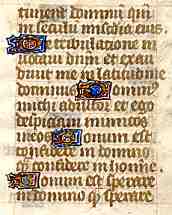 |
| Scribal Errors and Corrections (3) |
| Sometimes codes of graphic signs were used to indicate where a correction, written in the margin, was to be inserted. |
 |
An inserted word in the margin of a page of a 15th century missal, from a private collection. |
| In the above example, a slash and two dots is placed beside the word to be inserted in the margin, as well as in the spot where it is supposed to go in the text. The addition is in a different script to that of the main text, and has presumably been added by a later corrector. |
|
|
|
| No doubt with some less formal types of works. especially working scholarly texts covered with glosses and notes, the correction of a few scribal errors along the way was not a terribly serious issue. With elaborately produced posh volumes, the work of keeping a complete handwritten text error free must have been an arduous labour. However, in the most de luxe of volumes, the occasional error had to be dealt with. |
 |
| Line from the Luttrell Psalter, of c.1340, now in the British Library, f.149. |
| The words in the middle of the line above should have read in neomenia, but somehow it has become scrambled. The solution was to place an abbreviation mark over the i to indicate another n, and to insert a hyphen between in and eo. Given that the script, known as Gothic prescissa, is about the slowest and most painstaking to write and in this example has some very intricate little decorative flourishes, there must have been one scribe ready to bang his head on his writing desk with that one. |
| Sometimes errors were not corrected, and sometimes even copied on into new generations of the text. This is just a hazard of the manuscript tradition. The tracing of these variants can be used to construct a kind of genealogy for manuscripts, indicating their routes of transmission. The following example is an absolutely classic copyist's error of the sort you find in books about the psychology of reading. |
 |
The text of this very tiny book of hours is from Psalm 117 (118 in a modern Bible) and should read, starting from line 3: De tribulatione inuocaui dominum et exaudiuit me in latitudinem dominus. Dominus mihi adiutor non timebo quid faciat mihi homo. Dominus mihi adiutor et ego despiciam inimicos meos. Apart from the rendering of michi for mihi, a not uncommon medieval variant, the second sentence is missing. Two verses of the psalm begin with the same three words, and the scribe has accidentally omitted one of them. |
| Leaf from a 15th century miniature book of hours, from a private collection. |
| Given the permanent nature of their errors, it is no wonder that medieval scribes had a patron demon, Titivillus, who would sneak around collecting their uncorrected errors in a sack to present against them at the Day of Judgement. Workplace stress is not a modern invention. |
 previous page previous page |
 Tools
and Materials Tools
and Materials |
|
 |
 |
 |


